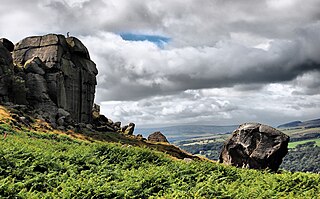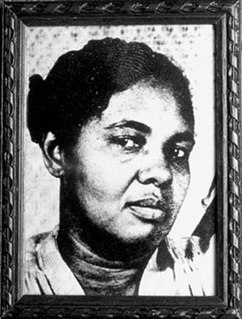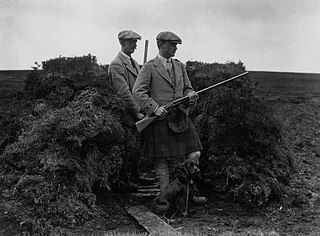
Bodmin Moor is a granite moorland in northeastern Cornwall, England. It is 208 square kilometres (80 sq mi) in size, and dates from the Carboniferous period of geological history. It includes Brown Willy, the highest point in Cornwall, and Rough Tor, a slightly lower peak. Many of Cornwall's rivers have their sources here. It has been inhabited since at least the Neolithic era, when primitive farmers started clearing trees and farming the land. They left their megalithic monuments, hut circles and cairns, and the Bronze Age culture that followed left further cairns, and more stone circles and stone rows. By medieval and modern times, nearly all the forest was gone and livestock rearing predominated.

Dartmoor is an upland area in southern Devon, England. The moorland and surrounding land has been protected by National Park status since 1951. Dartmoor National Park covers 954 km2 (368 sq mi).

Othello is a tragedy by William Shakespeare, probably written in 1603.

The term Moor is an exonym first used by Christian Europeans to designate the Muslim inhabitants of the Maghreb, the Iberian Peninsula, Sicily and Malta during the Middle Ages. The Moors initially were the indigenous Maghrebine Berbers. The name was later also applied to Arabs and Arabized Iberians.

The North York Moors is an upland area in north-eastern Yorkshire, England. It contains one of the largest expanses of heather moorland in the United Kingdom. The area was designated as a National Park in 1952, through the National Parks and Access to the Countryside Act 1949. Covering an area of 554 sq mi (1,430 km2), the National Park has a population of 23,380. It is administered by the North York Moors National Park Authority, whose head office is based in Helmsley.

The Moors murders were carried out by Ian Brady and Myra Hindley between July 1963 and October 1965, in and around Manchester, England. The victims were five children—Pauline Reade, John Kilbride, Keith Bennett, Lesley Ann Downey and Edward Evans—aged between 10 and 17, at least four of whom were sexually assaulted. Two of the victims were discovered in graves dug on Saddleworth Moor; a third grave was discovered there in 1987, more than twenty years after Brady and Hindley's trial. Bennett's body is also thought to be buried there, but despite repeated searches it remains undiscovered.

A mooring is any permanent structure to which a vessel may be secured. Examples include quays, wharfs, jetties, piers, anchor buoys, and mooring buoys. A ship is secured to a mooring to forestall free movement of the ship on the water. An anchor mooring fixes a vessel's position relative to a point on the bottom of a waterway without connecting the vessel to shore. As a verb, mooring refers to the act of attaching a vessel to a mooring.

Ilkley Moor is part of Rombalds Moor, the moorland between Ilkley and Keighley in West Yorkshire, England. The moor, which rises to 402 m (1,319 ft) above sea level, is well known as the inspiration for the Yorkshire "county anthem" On Ilkla Moor Baht 'at.

Liverpool John Moores University is a public research university in the city of Liverpool, England. The university can trace its origins to the Liverpool Mechanics' School of Arts, established in 1823. This later merged to become Liverpool Polytechnic. In 1992, following an Act of Parliament, the Liverpool Polytechnic became what is now Liverpool John Moores University. It is named after Sir John Moores, a local businessman and philanthropist, who donated to the university's precursor institutions.

Moorland or moor is a type of habitat found in upland areas in temperate grasslands, savannas, and shrublands and montane grasslands and shrublands biomes, characterised by low-growing vegetation on acidic soils. Moorland, nowadays, generally means uncultivated hill land, but also includes low-lying wetlands. It is closely related to heath, although experts disagree on what precisely distinguishes these types of vegetation. Generally, moor refers to highland and high rainfall zones whereas heath refers to lowland zones which are more likely to be the result of human activity. Moorland habitats mostly occur in tropical Africa, northern and western Europe, and neotropical South America. Most of the world's moorlands are very diverse ecosystems. In the extensive moorlands of the tropics, biodiversity can be extremely high. Moorland also bears a relationship to tundra, appearing as the tundra and the natural tree zone. The boundary between tundra and moorland constantly shifts with climatic change.

Islam in Sri Lanka existed in communities along the Arab coastal trade routes in Ceylon as soon as the religion originated and had gained early acceptance in the Arabian Peninsula. In the 16th century, descendants of Arab traders' were the main traders in spice, with networks extending to the Middle East, are now called the Sri Lankan Moors. About 1,967,227 persons adhere to Islam as per the census of 2012. Islam is a minority religion in Sri Lanka with 9.7% of the Sri Lankan population practice Islam.

Birmingham Moor Street is one of three main railway stations in the city centre of Birmingham, England, along with Birmingham New Street and Birmingham Snow Hill.

Turf Moor is an association football stadium in Burnley, Lancashire, England, which has been the home of Burnley F.C. since 1883. This unbroken service makes Turf Moor the second-longest continuously used ground in English professional football. The stadium is situated on Harry Potts Way, named after the manager who won the 1959–60 First Division with the club, and has a capacity of 21,944.

Le Coq Sportif is a French manufacturing company of sports equipment. Founded in 1882 by Émile Camuset and located in Entzheim, the company first issued items branded with its now-famous rooster trademark in 1948. The company's name and trademark are derived from the Gallic rooster, a national symbol of France.

Sri Lankan Moors are an ethnic minority group in Sri Lanka, comprising 9.2% of the country's total population. They are native speakers of the Arabic-influenced Tamil, who also speak Sinhalese as a second language. They are predominantly followers of Islam. The Sri Lankan Muslim community is divided as Sri Lankan Moors, Indian Moors and Sri Lankan Malays as per their history and traditions.
Peter Moores is a former English cricketer and coach who served two stints as the England national men's team head coach.

Solihull Moors Football Club is a professional football club based in Solihull, West Midlands, England. The club currently competes in the fifth tier of the English football league system, after achieving promotion from the National League North in the 2015–16 season.

Harriette Vyda Simms Moore was an American educator and civil rights worker. She was the wife of Harry T. Moore, who founded the first branch of the National Association for the Advancement of Colored People (NAACP) in Brevard County, Florida. The murder of the Moores was the first assassination to happen during the Civil Rights Movement and the only time both a husband and a wife were killed for their activism.

Driven grouse shooting is the hunting of the red grouse, a field sport of the United Kingdom. The grouse-shooting season extends from 12 August, often called the "Glorious Twelfth", to 10 December each year. Large numbers of grouse are driven to fly over people with shotguns. Driven grouse shooting first appeared around 1850 and became popular in the later Victorian era as a fashionable sport for the wealthy. The expanding rail network allowed relatively easy access into the remote upland areas of Britain for the first time and driven grouse shooting developed in tandem with this by providing shooting in a convenient and reliable form. Large numbers of birds are driven over a fixed position providing a regular supply of fast moving targets without the need to seek out the birds. The development of the breech-loading shotgun was also an essential ingredient in the development of the practice as it allowed more rapid reloading in the field matching the availability of target birds.






















